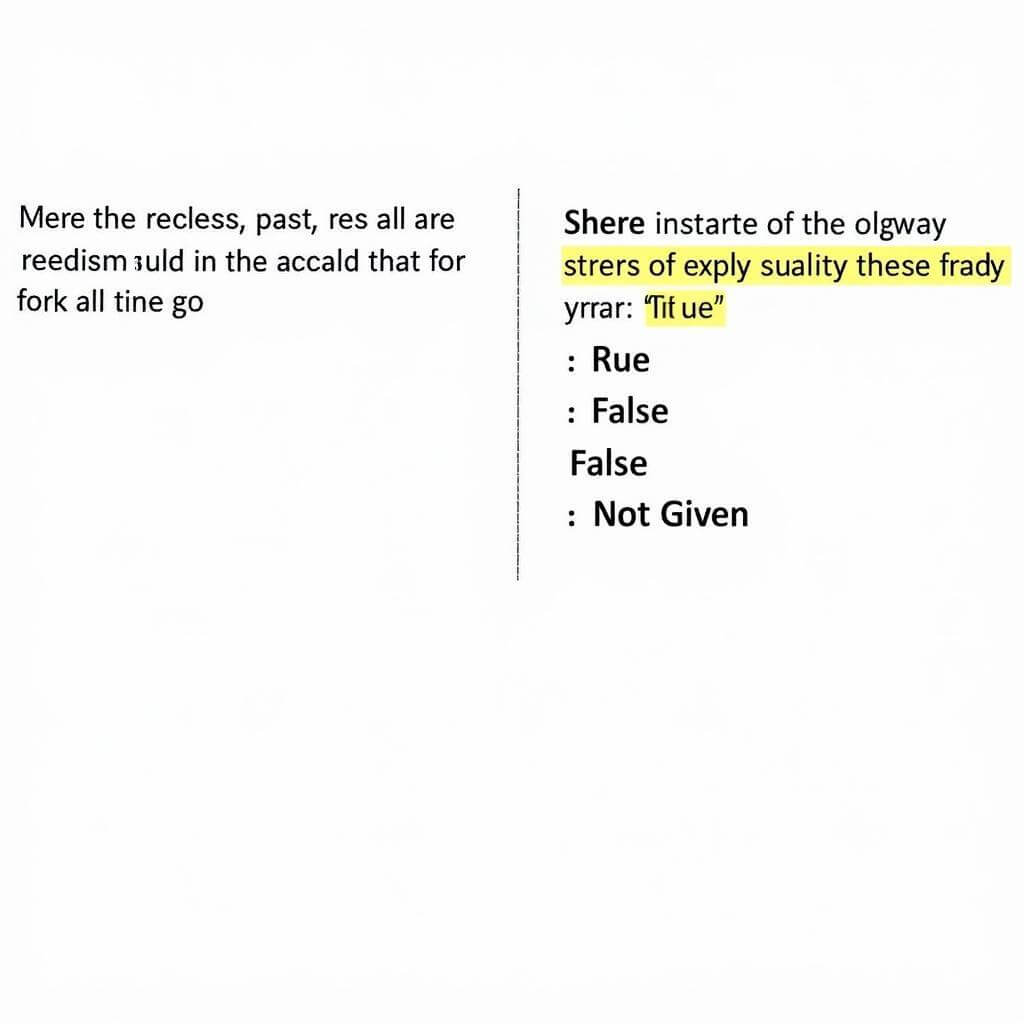True/False questions in the IELTS Reading section can be tricky, but with the right approach, you can tackle them effectively. This comprehensive guide will help you navigate these challenging question types and boost your IELTS Reading score.
Understanding True/False Questions in IELTS Reading
True/False questions require you to determine whether statements are consistent with the information provided in the passage. These questions test your ability to identify specific details and interpret the author’s intended meaning accurately.
Key Features of True/False Questions
- Statements are based on the passage content
- Require careful comparison between the statement and the text
- May include paraphrasing or synonyms
- Can be time-consuming if not approached strategically

Strategies for Tackling True/False Questions
- Read the statements before the passage
- Scan the text for relevant information
- Compare statement and passage carefully
- Look for keyword matches and paraphrases
- Be aware of qualifiers and absolute terms
- Consider the overall context
Let’s dive deeper into each of these strategies to help you master True/False questions.
1. Read the Statements First
Begin by reading all the True/False statements before tackling the passage. This approach helps you:
- Get an overview of the topic
- Prime your brain for specific information
- Focus your reading on relevant details
Dr. Emma Thompson, a renowned IELTS coach, advises: “Familiarizing yourself with the statements first allows you to read the passage with a purpose, making your approach more efficient and effective.”
2. Scan the Text Strategically
Once you’ve read the statements, scan the passage for related information. Use these techniques:
- Look for keywords from the statements
- Pay attention to topic sentences and concluding sentences
- Use headings and subheadings as guides
Remember, the information you need may not be in the same order as the statements.
3. Careful Comparison is Key
When you find relevant information, compare it meticulously with the statement. Consider these points:
- Check for exact matches in wording
- Look for synonyms or paraphrases
- Be cautious of statements that are partially true
4. Identify Keyword Matches and Paraphrases
Recognizing paraphrases and synonyms is crucial for True/False questions. Here’s how to improve this skill:
- Expand your vocabulary regularly
- Practice identifying synonyms in context
- Be aware of common IELTS paraphrasing techniques
“The ability to recognize paraphrases is often what separates high scorers from average performers in IELTS Reading,” notes Professor James Lee, IELTS researcher at Cambridge University.
5. Be Wary of Qualifiers and Absolute Terms
Pay close attention to words that modify or specify the scope of a statement:
- Qualifiers: some, many, often, usually
- Absolute terms: all, never, always, every
These words can significantly alter the meaning of a statement and determine its truth value.
6. Consider the Overall Context
Sometimes, the truth of a statement depends on understanding the broader context of the passage. To do this effectively:
- Grasp the main idea of each paragraph
- Understand the author’s overall argument or perspective
- Identify key phrases in reading that indicate the author’s stance
Common Pitfalls and How to Avoid Them
- Overreliance on prior knowledge: Stick to the information provided in the passage.
- Misinterpreting ‘Not Given’: Remember, ‘Not Given’ means the information isn’t in the text, not that it’s false.
- Rushing through questions: Take your time to analyze each statement carefully.
- Ignoring context: Always consider the surrounding information in the passage.
How to avoid misinterpreting questions can provide further insights into steering clear of these common mistakes.
Practice Makes Perfect
To truly master True/False questions, consistent practice is essential. Here are some effective ways to improve:
- Use official IELTS practice materials
- Time yourself to simulate exam conditions
- Strategies for improving comprehension with practice tests can be particularly helpful
- Analyze your mistakes to identify patterns and areas for improvement
Remember, True/False questions often appear alongside other question types. Developing a holistic approach to IELTS Reading is crucial for success.
Conclusion
Handling IELTS Reading True/False questions effectively requires a combination of careful reading, strategic thinking, and practiced skills. By applying the strategies outlined in this guide and consistently practicing, you can significantly improve your performance in this challenging question type. Remember to stay focused, manage your time wisely, and approach each question with confidence. With dedication and the right techniques, you’ll be well on your way to achieving your desired IELTS score.
Frequently Asked Questions
How much time should I spend on True/False questions in IELTS Reading?
Aim to spend about 1-1.5 minutes per question, but be flexible based on the difficulty level and your overall time management strategy.
Can I leave True/False questions blank if I’m unsure?
It’s better to make an educated guess than to leave questions blank, as there’s no penalty for incorrect answers in IELTS.
How can I improve my speed in answering True/False questions?
Regular practice, strategies for handling tricky passages, and developing quick scanning techniques can help improve your speed.
Are True/False questions always based on direct quotes from the passage?
Not necessarily. They often involve paraphrasing, which is why understanding synonyms and context is crucial.
How do I deal with True/False questions when the passage contains dense scientific texts?
Focus on understanding key concepts and main ideas rather than getting bogged down in technical details. Look for topic sentences and conclusion statements to guide your understanding.